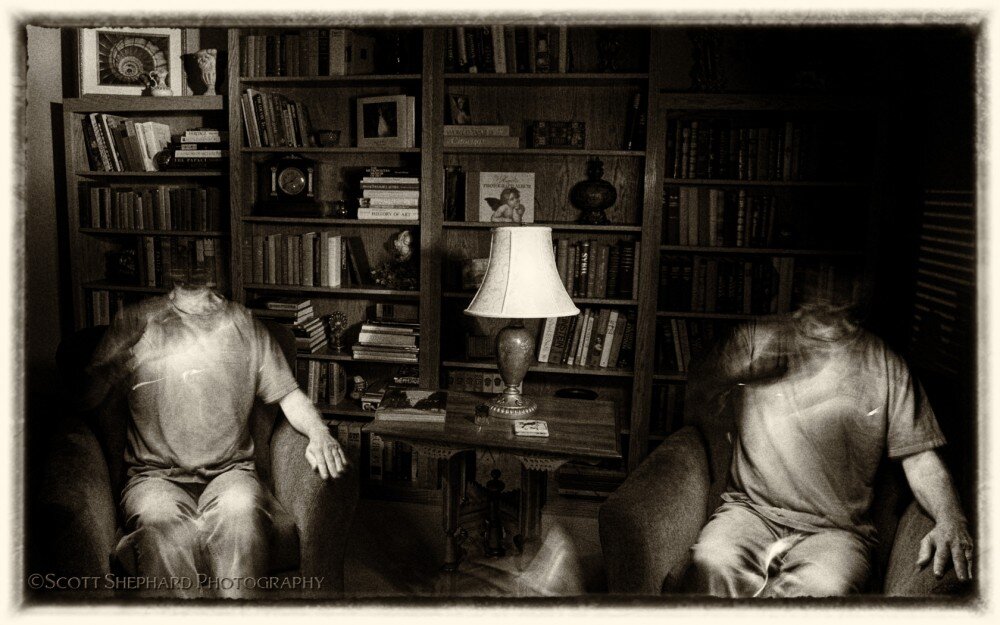 Yes, the man in the chairs is me. (I struggled hard with the grammar of this sentence.)What you are looking at is my rudimentary first attempt at light painting, which uses a long shutter speed and a flashlight of some sort. I didn't paint my head because it was very early in morning and I hadn't fixed my unruly hair yet. Plus, this photo looks better without faces on me.Happy Halloween!Canon 5DII 30s f/6.3 ISO800 24mm
Yes, the man in the chairs is me. (I struggled hard with the grammar of this sentence.)What you are looking at is my rudimentary first attempt at light painting, which uses a long shutter speed and a flashlight of some sort. I didn't paint my head because it was very early in morning and I hadn't fixed my unruly hair yet. Plus, this photo looks better without faces on me.Happy Halloween!Canon 5DII 30s f/6.3 ISO800 24mm
Photography
Out By Lonesome Lake (LATI Festival of Trees Choice)
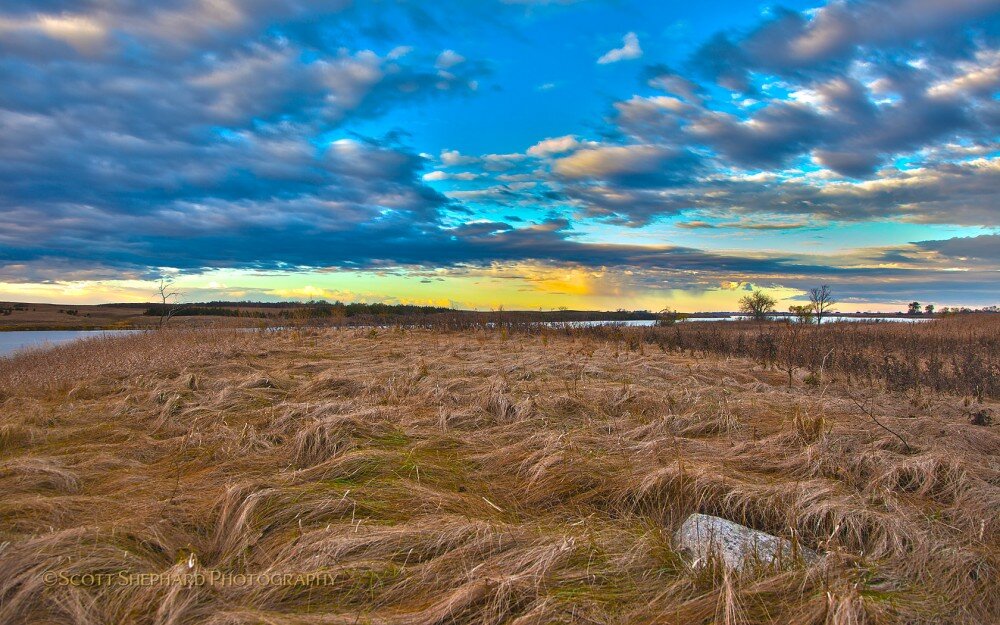 One of the good things about my job is that when I give a photo assignment I often go out and do the assignment myself. Such was the case this past weekend. My particular mission was to shoot an HDR photo or two. I have spent about 10 hours on this task and, of the 300 photos I took, I've ended up with one HDR composite that I like. That's not bad for a day's work!I have posted an HDR (High Dynamic Range) to this blog before but I thought I'd do it again. In simple terms, an HDR photo is really one or more photos of the exact same subject with varying exposures layered on top of each other and adjusted so the whole photo is well exposed - from the very bright to the very dark.In the case of today's photo, if I had exposed for the beautiful morning sky, the grass in the foreground would have been barely visible. And if I'd exposed for the foreground, the sky would have been washed out. I must admit that the way I've done HDR so far has an element of the surreal in it. And I like that.Incidentally, this photo has been selected as this year's choice for my LATI Festival of Trees donation. It will be among many things that are donated and offered during the silent auction for the annual LATI scholarship fundraiser on November 18 at the Ramkota.Finally, if you are still reading this, you may be seriously interested in HDR. If that's true, go here to see a YouTube video I made on this subject.
One of the good things about my job is that when I give a photo assignment I often go out and do the assignment myself. Such was the case this past weekend. My particular mission was to shoot an HDR photo or two. I have spent about 10 hours on this task and, of the 300 photos I took, I've ended up with one HDR composite that I like. That's not bad for a day's work!I have posted an HDR (High Dynamic Range) to this blog before but I thought I'd do it again. In simple terms, an HDR photo is really one or more photos of the exact same subject with varying exposures layered on top of each other and adjusted so the whole photo is well exposed - from the very bright to the very dark.In the case of today's photo, if I had exposed for the beautiful morning sky, the grass in the foreground would have been barely visible. And if I'd exposed for the foreground, the sky would have been washed out. I must admit that the way I've done HDR so far has an element of the surreal in it. And I like that.Incidentally, this photo has been selected as this year's choice for my LATI Festival of Trees donation. It will be among many things that are donated and offered during the silent auction for the annual LATI scholarship fundraiser on November 18 at the Ramkota.Finally, if you are still reading this, you may be seriously interested in HDR. If that's true, go here to see a YouTube video I made on this subject.
Through the Bus Window
 I went to Sica Hollow, west of Sisseton, SD, with several of my photo students. Sica Hollow is a state park that I thought would provide unique photo opportunities for photographers. We were closing in on the park when I thought I should take a photo. What struck me about this this scene, of course, is the color and the landscape.When I took the photo, I was hoping to get the driver, Ronnie, and a well exposed landscape. The camera was a Canon SX230 HS and I was impressed with the range that this camera was able to capture in this photo - from the bright, blue sky to the subdued tones of Ronnie.This may be one of those photos I like more because of what it helps me remember about this trip than because I think it is a good photograph.For a little insight into the creative process that went into this video, watch this three minute screen cast.
I went to Sica Hollow, west of Sisseton, SD, with several of my photo students. Sica Hollow is a state park that I thought would provide unique photo opportunities for photographers. We were closing in on the park when I thought I should take a photo. What struck me about this this scene, of course, is the color and the landscape.When I took the photo, I was hoping to get the driver, Ronnie, and a well exposed landscape. The camera was a Canon SX230 HS and I was impressed with the range that this camera was able to capture in this photo - from the bright, blue sky to the subdued tones of Ronnie.This may be one of those photos I like more because of what it helps me remember about this trip than because I think it is a good photograph.For a little insight into the creative process that went into this video, watch this three minute screen cast.
On Location
 Here are a few of my favorite people in one of my favorite places. The place: the old Redlin farmstead 15 miles north of Watertown. The people: Kendra, Sara, Ashley, McKenzie, Kelly, Holly and Alli (sitting). These are 6 of my second year Photo/Media students at LATI and one of my first year students (Alli). The occasion was an on-location portrait shoot.When I was doing senior portraits, I used to bring my subjects out to this old farm all the time. I liked the many looks that the buildings could give a portrait but I also liked how I could find spots with good light that were also protected from the wind. Wind is rarely an outdoor portrait artist's friend, especially with females. And in South Dakota, windy days are more common than calm ones.I had a good time on the day I took this photo but I think most of my students got better results than I did, which is what I would hope for.
Here are a few of my favorite people in one of my favorite places. The place: the old Redlin farmstead 15 miles north of Watertown. The people: Kendra, Sara, Ashley, McKenzie, Kelly, Holly and Alli (sitting). These are 6 of my second year Photo/Media students at LATI and one of my first year students (Alli). The occasion was an on-location portrait shoot.When I was doing senior portraits, I used to bring my subjects out to this old farm all the time. I liked the many looks that the buildings could give a portrait but I also liked how I could find spots with good light that were also protected from the wind. Wind is rarely an outdoor portrait artist's friend, especially with females. And in South Dakota, windy days are more common than calm ones.I had a good time on the day I took this photo but I think most of my students got better results than I did, which is what I would hope for.
Mercurial II
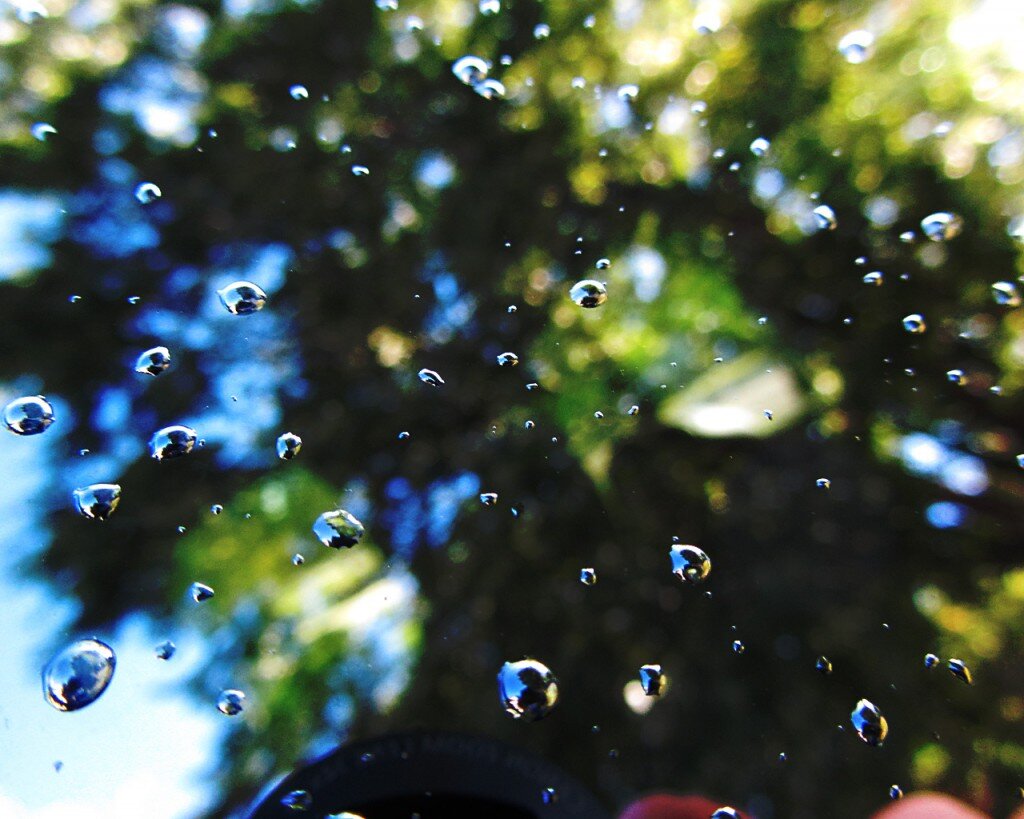 I've compared water drops to mercury before in this blog. But for those who have seen beads of mercury, you'd have to admit that these water drops, photographed from the inside of my pickup's front window, look more like silvery mercury than beads of water.A good photo? You'll make that judgement. A different view of reality? As a photographer, I try to offer that from time to time.Incidentally, this photo was taken with a Canon SX230 HS, a palm-sized point-and-shoot camera. I'm impressed with its ability to blur the background. And provide a little bokeh! Notice, incidentally, that the tree in the background is blurred but that each water drop acts as a lens and offers a somewhat focused view of the same tree.CanonSX230 HS 1/30s f/3.1 ISO640 5mm
I've compared water drops to mercury before in this blog. But for those who have seen beads of mercury, you'd have to admit that these water drops, photographed from the inside of my pickup's front window, look more like silvery mercury than beads of water.A good photo? You'll make that judgement. A different view of reality? As a photographer, I try to offer that from time to time.Incidentally, this photo was taken with a Canon SX230 HS, a palm-sized point-and-shoot camera. I'm impressed with its ability to blur the background. And provide a little bokeh! Notice, incidentally, that the tree in the background is blurred but that each water drop acts as a lens and offers a somewhat focused view of the same tree.CanonSX230 HS 1/30s f/3.1 ISO640 5mm
Breaking Ground
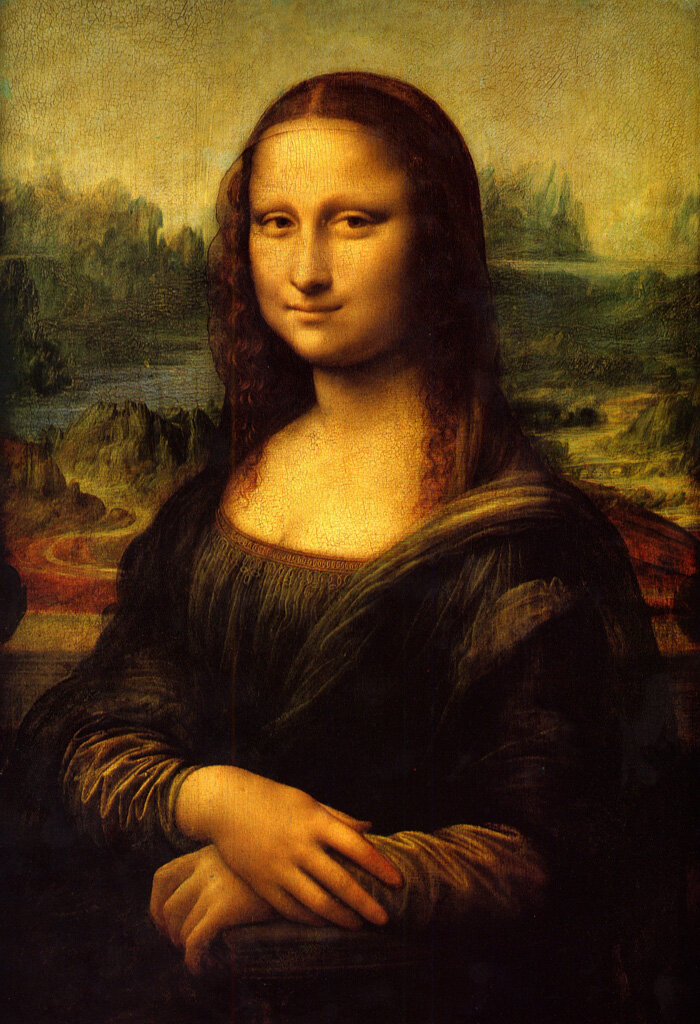 OK, so in a minor way I am breaking ground in this blog because I am A)publishing a painting and B)I am posting someone else's work. Why, you ask?The answer is that I am assigning a "Copy Da Vinci" portrait assignment to my studio photography students and I thought this might also teach you a little about how you might improve your portraits.What Da Vinci did in this painting that helped shape the future of portraiture lies in part in the way the subject is posed. Generally, portraits were full-body and in profile mode before Da Vinci. What Da Vinci did is that he angled Mona Lisa and chose to show us a view of her that focused on her face. Imagine that!Additionally, Mono Lisa is looking right at us and smiling that famous smile. The angle of her shoulders and the gentle position of her hands make Mona Lisa seem relaxed and real. Of course we try to get the same effect in modern portraits.Da Vinci did do one thing that I would tell my photography students not to do and it has to do with the way the hands are posed. These days the general rule that that the back of the hand should never face the camera. What that does is that it presents an element in the photo (due to its size and brightness) that that competes with the face. And a portrait generally is all about the face.Da Vinci gets away with this hand showing because of the neat, nearly triangular shape that defines Mona. And, of course, the face is what clearly dominates this painting.Do you want to take good photos? How about finding some great works of art and copying them. When you start to copy, you start to see techniques and compositional elements that you may not have otherwise seen.
OK, so in a minor way I am breaking ground in this blog because I am A)publishing a painting and B)I am posting someone else's work. Why, you ask?The answer is that I am assigning a "Copy Da Vinci" portrait assignment to my studio photography students and I thought this might also teach you a little about how you might improve your portraits.What Da Vinci did in this painting that helped shape the future of portraiture lies in part in the way the subject is posed. Generally, portraits were full-body and in profile mode before Da Vinci. What Da Vinci did is that he angled Mona Lisa and chose to show us a view of her that focused on her face. Imagine that!Additionally, Mono Lisa is looking right at us and smiling that famous smile. The angle of her shoulders and the gentle position of her hands make Mona Lisa seem relaxed and real. Of course we try to get the same effect in modern portraits.Da Vinci did do one thing that I would tell my photography students not to do and it has to do with the way the hands are posed. These days the general rule that that the back of the hand should never face the camera. What that does is that it presents an element in the photo (due to its size and brightness) that that competes with the face. And a portrait generally is all about the face.Da Vinci gets away with this hand showing because of the neat, nearly triangular shape that defines Mona. And, of course, the face is what clearly dominates this painting.Do you want to take good photos? How about finding some great works of art and copying them. When you start to copy, you start to see techniques and compositional elements that you may not have otherwise seen.
Emily
 This is a photo that I took a few years ago and used as a retouching demonstration for my Studio Photography class. It takes about 20 minutes per portrait to do the things I think need to be done, though I have Photoshop actions and filters that would do some of the same things in seconds. But while I think automation is generally good, the personal, discretionary touch of the photographer is usually better.A general retouching philosophy of mine is to avoid the temptation to "Photoshop" a photo too much. I told my students that I think that when the retouching is finished, the "real person" should remain. Skin texture, teeth color, beauty marks and scars are part of who we are. This photo of Emily is a fairly low resolution copy, but I think the an 8x10 print of this picture would reveal the "real" Emily.Canon 5dII 1/640s f/3.5 ISO400 135mm Canon 70-200 2.8 Lens
This is a photo that I took a few years ago and used as a retouching demonstration for my Studio Photography class. It takes about 20 minutes per portrait to do the things I think need to be done, though I have Photoshop actions and filters that would do some of the same things in seconds. But while I think automation is generally good, the personal, discretionary touch of the photographer is usually better.A general retouching philosophy of mine is to avoid the temptation to "Photoshop" a photo too much. I told my students that I think that when the retouching is finished, the "real person" should remain. Skin texture, teeth color, beauty marks and scars are part of who we are. This photo of Emily is a fairly low resolution copy, but I think the an 8x10 print of this picture would reveal the "real" Emily.Canon 5dII 1/640s f/3.5 ISO400 135mm Canon 70-200 2.8 Lens
Window Seat (iPhoneography)
 When I travel, I am as captivated by looking at the scenery as any other tourist. But if the situation allows it, I also like to take photos of people looking at the scenery. I guess I'm a bit of a voyeur in that sense.In this case, I was on a plane flying over the Grand Canyon on an amazingly clear day. I must have taken 50 photos with my iPhone before I noticed a young girl in the window seat ahead of me who was also captivated by what we were seeing 30,000 feet below us.And so I snapped this photo.
When I travel, I am as captivated by looking at the scenery as any other tourist. But if the situation allows it, I also like to take photos of people looking at the scenery. I guess I'm a bit of a voyeur in that sense.In this case, I was on a plane flying over the Grand Canyon on an amazingly clear day. I must have taken 50 photos with my iPhone before I noticed a young girl in the window seat ahead of me who was also captivated by what we were seeing 30,000 feet below us.And so I snapped this photo.
Shadow and Light
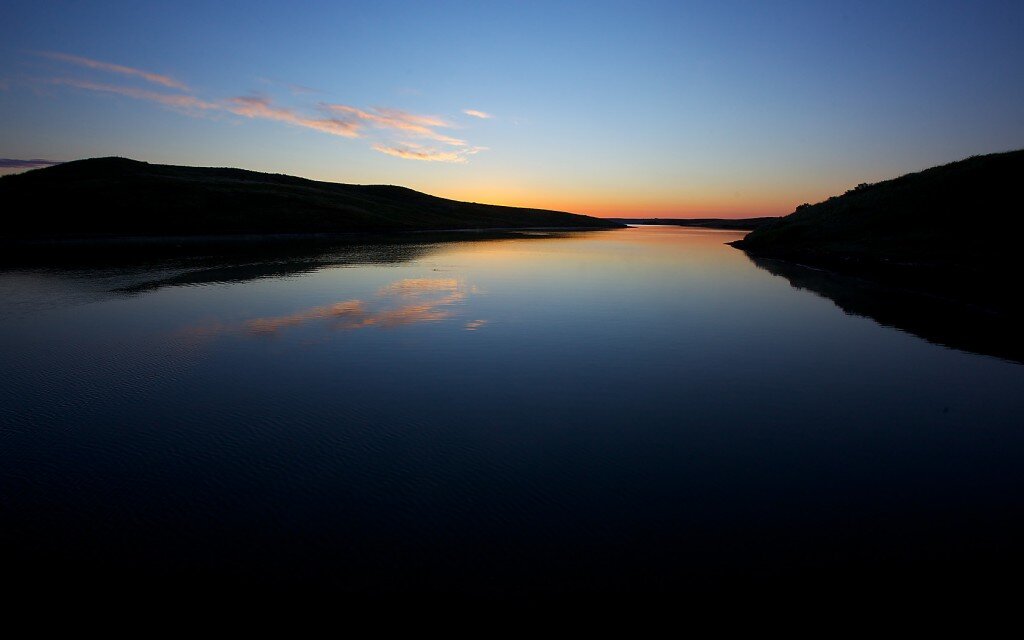 This is the fourth in a series of sunrise shots that were all taken within 30 minutes or so of each other. This photo was almost rejected (which is my way of throwing things away - kind of). The rejection would have been based on the fact that so little is well exposed on this frame. In fact I would say that as much as 1/2 of this photo is almost pure black. In my mind, that's not good.But, when I looked at this picture again, I like how the black parts of the photo frame the incipient sunrise. I think that how the water goes from black to deep blue to orange is especially interesting.So this one became a keeper.
This is the fourth in a series of sunrise shots that were all taken within 30 minutes or so of each other. This photo was almost rejected (which is my way of throwing things away - kind of). The rejection would have been based on the fact that so little is well exposed on this frame. In fact I would say that as much as 1/2 of this photo is almost pure black. In my mind, that's not good.But, when I looked at this picture again, I like how the black parts of the photo frame the incipient sunrise. I think that how the water goes from black to deep blue to orange is especially interesting.So this one became a keeper.
A Little Coffee
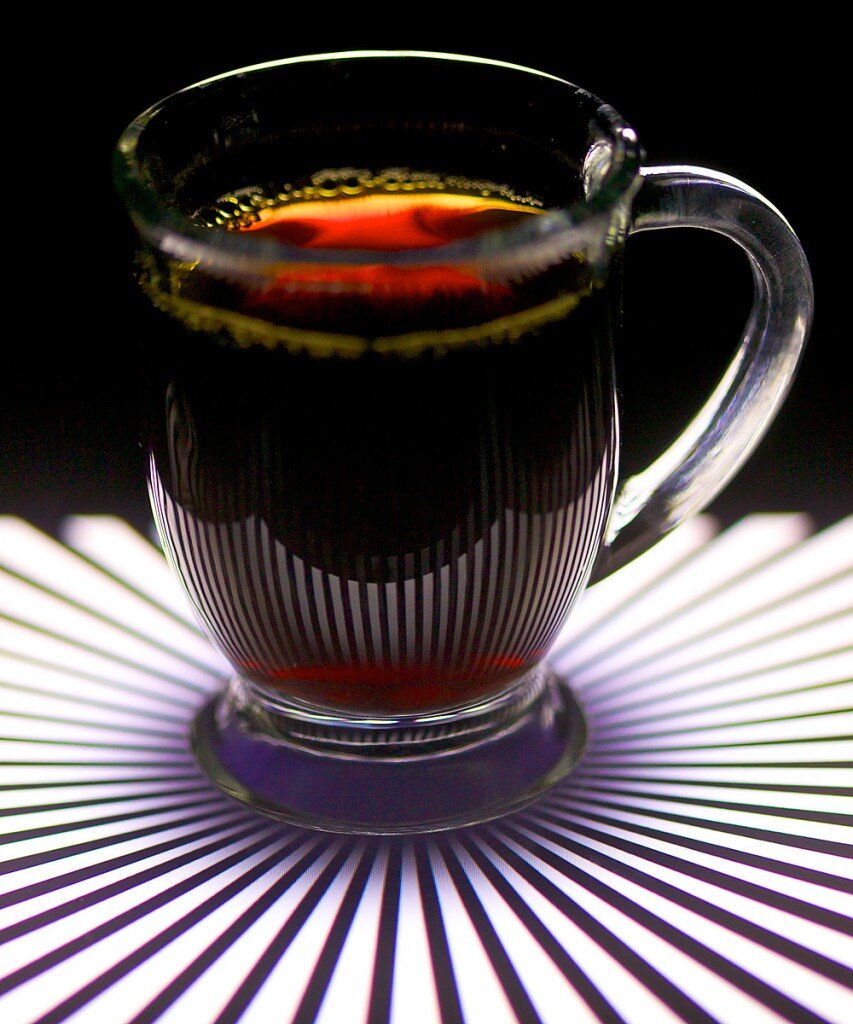 I took this quite a while ago using an iPad app I had read about called Photo Soft Box. You set any number of patterns on your iPad, find a dark room and an object that has interesting reflectivity and then take photos. I think it's pretty cool and a creative eye might find interesting things to do with this tool. Maybe sometime soon I'll give this app the time it deserves.
I took this quite a while ago using an iPad app I had read about called Photo Soft Box. You set any number of patterns on your iPad, find a dark room and an object that has interesting reflectivity and then take photos. I think it's pretty cool and a creative eye might find interesting things to do with this tool. Maybe sometime soon I'll give this app the time it deserves.
I Am No Claude Monet
 Nor was meant to be. (As TS Elliot might say.)*But just as Monet painted canvas after canvas of haystacks in different light, I seem to photograph clouds at sunrise fairly regularly. Redundant? Just as it was with Monet, for me it's not so much about the subject; it's about the light. And the place. . . .*No! I am not Prince Hamlet, nor was meant to be;Am an attendant lord, one that will doTo swell a progress, start a scene or twoAdvise the prince; no doubt, an easy tool,Deferential, glad to be of use,Politic, cautious, and meticulous;Full of high sentence, but a bit obtuse;At times, indeed, almost ridiculous—Almost, at times, the Fool.Love Song of J. Alfred Prufrock
Nor was meant to be. (As TS Elliot might say.)*But just as Monet painted canvas after canvas of haystacks in different light, I seem to photograph clouds at sunrise fairly regularly. Redundant? Just as it was with Monet, for me it's not so much about the subject; it's about the light. And the place. . . .*No! I am not Prince Hamlet, nor was meant to be;Am an attendant lord, one that will doTo swell a progress, start a scene or twoAdvise the prince; no doubt, an easy tool,Deferential, glad to be of use,Politic, cautious, and meticulous;Full of high sentence, but a bit obtuse;At times, indeed, almost ridiculous—Almost, at times, the Fool.Love Song of J. Alfred Prufrock
Still Seeing Green
 I took this photo this summer but when and where I don't remember. For me, this is unusual since taking a photo is rarely a casual or unconscious decision. I am generally pretty "focused" and very aware of the subject, the place and the act.This photo isn't anything to write home about, though there is something simple and elemental in drops of water on deep green leaves. And I do like taking photos of vegetation.
I took this photo this summer but when and where I don't remember. For me, this is unusual since taking a photo is rarely a casual or unconscious decision. I am generally pretty "focused" and very aware of the subject, the place and the act.This photo isn't anything to write home about, though there is something simple and elemental in drops of water on deep green leaves. And I do like taking photos of vegetation.
